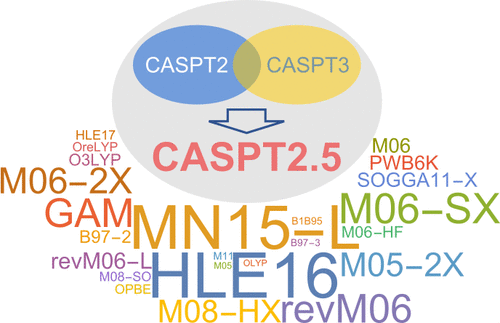当前位置:
X-MOL 学术
›
J. Chem. Theory Comput.
›
论文详情
Our official English website, www.x-mol.net, welcomes your feedback! (Note: you will need to create a separate account there.)
Spin Splitting Energy of Transition Metals: A New, More Affordable Wave Function Benchmark Method and Its Use to Test Density Functional Theory.
Journal of Chemical Theory and Computation ( IF 5.5 ) Pub Date : 2020-06-11 , DOI: 10.1021/acs.jctc.0c00518 Dayou Zhang 1 , Donald G Truhlar 1
Journal of Chemical Theory and Computation ( IF 5.5 ) Pub Date : 2020-06-11 , DOI: 10.1021/acs.jctc.0c00518 Dayou Zhang 1 , Donald G Truhlar 1
Affiliation

|
Accurately predicting the spin splitting energy of chemical species is important for understanding their reactivity and magnetic properties, but it is very challenging, especially for molecules containing transition metals. One impediment to progress is the scarcity of accurate benchmark data. Here we report a set of calculations designed to yield reliable benchmarks for simple transition-metal complexes that can be used to test density functional methods that are affordable for large systems of more practical interest. Various wave function methods are tested against experiment for Fe2+, Fe3+, and Co3+, including CASSCF, CASPT2, CASPT3, MRCISD, MRCISD+Q, ACPF, AQCC, CCSD(T), and CASPT2/CCSD(T) and also a new method called CASPT2.5, which is performed by taking the average of the CASPT2 and CASPT3 energies. We find that MRCISD+Q, ACPF, and AQCC require smaller active spaces for good accuracy than are required by CASPT2 and CASPT3, and this aspect may be important for calculations on larger molecules; here we find that CASPT2.5 extrapolated to a complete basis set is the most suitable method—in terms of computational cost and in terms of accuracy on monatomic systems—and therefore we chose this method for molecular benchmarks. Then Kohn–Sham density functional calculations with 60 exchange-correlation functionals are tested for FeF2, FeCl2, and CoF2. We find that MN15-L, M06-SX, and revM06 have very good agreement with CASPT2.5 benchmarks in terms of both the spin splitting energy and the optimized geometry for each spin state. In addition, we recommend def2-TZVP as the most suitable basis set to perform density functional calculations for molecular spin splitting energies; extra polarization functions in the basis set do not help to increase the accuracy of the spin splitting energy in KS calculations.
中文翻译:

过渡金属的自旋分裂能:一种新的,价格更实惠的波函数基准方法及其在测试密度泛函理论中的用途。
准确预测化学物种的自旋分裂能对于理解其反应性和磁性非常重要,但是这非常具有挑战性,特别是对于包含过渡金属的分子而言。取得进展的一个障碍是缺乏准确的基准数据。在这里,我们报告了一组计算结果,这些计算结果旨在为简单的过渡金属配合物提供可靠的基准,可用于测试密度泛函方法,该方法对于具有更大实际意义的大型系统是可以承受的。针对Fe 2 +,Fe 3+和Co 3+的实验,测试了各种波动函数方法包括CASSCF,CASPT2,CASPT3,MRCISD,MRCISD + Q,ACPF,AQCC,CCSD(T)和CASPT2 / CCSD(T),以及一种称为CASPT2.5的新方法,该方法通过取CASPT2的平均值来执行和CASPT3能量。我们发现,与CISPT2和CASPT3相比,MRCISD + Q,ACPF和AQCC需要较小的有效空间才能获得更高的精度,并且这对于较大分子的计算可能很重要。在这里,我们发现外推到完整基础集的CASPT2.5是最合适的方法(就计算成本和单原子系统的准确性而言),因此我们选择此方法作为分子基准。然后针对FeF 2,FeCl 2和CoF 2测试具有60个交换相关函数的Kohn-Sham密度函数计算。。我们发现,MN15-L,M06-SX和revM06在自旋分裂能和每种自旋状态的优化几何形状方面都与CASPT2.5基准非常吻合。另外,我们建议使用def2-TZVP作为最合适的基础集,以执行分子自旋分裂能的密度泛函计算。基集中的额外极化函数无助于在KS计算中提高自旋分裂能量的准确性。
更新日期:2020-07-14
中文翻译:

过渡金属的自旋分裂能:一种新的,价格更实惠的波函数基准方法及其在测试密度泛函理论中的用途。
准确预测化学物种的自旋分裂能对于理解其反应性和磁性非常重要,但是这非常具有挑战性,特别是对于包含过渡金属的分子而言。取得进展的一个障碍是缺乏准确的基准数据。在这里,我们报告了一组计算结果,这些计算结果旨在为简单的过渡金属配合物提供可靠的基准,可用于测试密度泛函方法,该方法对于具有更大实际意义的大型系统是可以承受的。针对Fe 2 +,Fe 3+和Co 3+的实验,测试了各种波动函数方法包括CASSCF,CASPT2,CASPT3,MRCISD,MRCISD + Q,ACPF,AQCC,CCSD(T)和CASPT2 / CCSD(T),以及一种称为CASPT2.5的新方法,该方法通过取CASPT2的平均值来执行和CASPT3能量。我们发现,与CISPT2和CASPT3相比,MRCISD + Q,ACPF和AQCC需要较小的有效空间才能获得更高的精度,并且这对于较大分子的计算可能很重要。在这里,我们发现外推到完整基础集的CASPT2.5是最合适的方法(就计算成本和单原子系统的准确性而言),因此我们选择此方法作为分子基准。然后针对FeF 2,FeCl 2和CoF 2测试具有60个交换相关函数的Kohn-Sham密度函数计算。。我们发现,MN15-L,M06-SX和revM06在自旋分裂能和每种自旋状态的优化几何形状方面都与CASPT2.5基准非常吻合。另外,我们建议使用def2-TZVP作为最合适的基础集,以执行分子自旋分裂能的密度泛函计算。基集中的额外极化函数无助于在KS计算中提高自旋分裂能量的准确性。



























 京公网安备 11010802027423号
京公网安备 11010802027423号